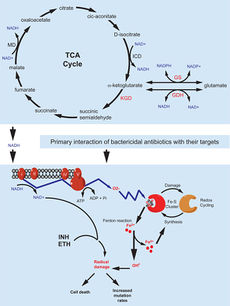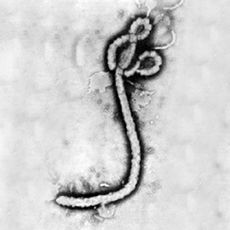Drug Resistance in Mycobacterium Tuberculosis: Difference between revisions
No edit summary |
|||
| Line 1: | Line 1: | ||
{{Uncurated}} | {{Uncurated}} | ||
[http://en.wikipedia.org/wiki/Tuberculosis Tuberculosis] (TB) is a potentially deadly disease caused by pathogenic bacteria, usually <i>Mycobacterium tuberculosis</i> It has existed in humans since ancient times and had high mortality rates without adequate treatment options before the invention of [http://en.wikipedia.org/wiki/Antibiotics antibiotics] , specifically [http://en.wikipedia.org/wiki/Streptomycin streptomycin] in 1943, that were potent enough to kill the bacteria. [[#References|[6]]] In the 1960’s, following a drastic reduction in TB rates around the world, people began to predict that the disease could be completely eradicated within a century. [[#References|[5]]] However, this goal proved overly-optimistic as drug-resistant strains had begun to emerge since the first use of antibiotics to treat TB. At first this was mainly due to only using a single drug, streptomycin, to treat the infection, prompting the use of multi-drug therapy but in recent decades [http://en.wikipedia.org/wiki/Multi-drug-resistant_tuberculosis multi-drug resistant] (MDR), [http://en.wikipedia.org/wiki/Extensively_drug-resistant_tuberculosis extensively- drug resistant] (XDR), and [http://en.wikipedia.org/wiki/Totally_drug-resistant_tuberculosis totally-drug resistant] (TDR) strains of TB have emerged. [[#References|[1]]] Many of these strains are effectively incurable, especially the XDR and TDR strains, even for patients with access to an array of anti-TB drugs. [[#References|[1]]] Given their grave public health threat it is crucial to study the molecular biology of the intrinsic and acquired mechanisms of resistance in <i>M. tuberculosis</i> in order to develop new drugs that avoid these mechanisms. | |||
== | ==Intrinsic Drug Resistance == | ||
| Line 39: | Line 39: | ||
==References== | ==References== | ||
[ | 1. [http://www.ncbi.nlm.nih.gov/pubmed/21558086 Almeida Da Silva PE, Palomino JC. Molecular basis and mechanisms of drug resistance in mycobacterium tuberculosis: Classical and new drugs. J Antimicrob Chemother 2011 JUL;66(7):1417-30.] | ||
2. [http://journals.plos.org/plospathogens/article?id=10.1371/journal.ppat.1000645 Christophe T, Jackson M, Jeon HK, Fenistein D, Contreras-Dominguez M, Kim J, Genovesio A, Carralot J, Ewann F, Kim EH, et al. High content screening identifies decaprenyl-phosphoribose 2 ' epimerase as a target for intracellular antimycobacterial inhibitors. Plos Pathogens 2009 OCT;5(10):e1000645.] | |||
3. [http://www.ncbi.nlm.nih.gov/pubmed/25182646 Cui Z, Li Y, Cheng S, Yang H, Lu J, Hu Z, Ge B. Mutations in the embC-embA intergenic region contribute to mycobacterium tuberculosis resistance to ethambutol. Antimicrob Agents Chemother 2014 NOV;58(11):6837-43.] | |||
4. [http://www.ncbi.nlm.nih.gov/pubmed/?term=PCR-based+methodology+for+detecting+multidrug-resistant+strains+of+Mycobacterium+tuberculosis+Beijing+family+circulating+in+Russia. Mokrousov I, Otten T, Vyazovaya A, Limeschenko E, Filipenko M, Sola C, Rastogi N, Steklova L, Vyshnevskiy B, Narvskaya O. PCR-based methodology for detecting multidrug-resistant strains of mycobacterium tuberculosis beijing family circulating in russia. European Journal of Clinical Microbiology & Infectious Diseases 2003 JUN;22(6):342-8. ] | |||
5. [http://www.ncbi.nlm.nih.gov/pubmed/?term=Mycobacterial+subversion+of+chemotherapeutic+reagents+and+host+defense+tactics%3A+challenges+in+tuberculosis+drug+development. Nguyen L, Pieters J. Mycobacterial subversion of chemotherapeutic reagents and host defense tactics: challenges in tuberculosis drug development. Annu Rev Pharmacol Toxicol. 2009;49:427-53. doi: 10.1146/annurev-pharmtox-061008-103123. Review. PubMed PMID: 19281311.] | |||
6. [http://www.ncbi.nlm.nih.gov/pmc/articles/PMC3982203/#R117 Smith T, Wolff KA, Nguyen L. Molecular Biology of Drug Resistance in Mycobacterium tuberculosis. Current topics in microbiology and immunology. 2013;374:53-80. doi:10.1007/82_2012_279.] | |||
7. [http://www.ncbi.nlm.nih.gov/pubmed/25465521 Zhao L, Sun Q, Zeng C, Chen Y, Zhao B, Liu H, Xia Q, Zhao X, Jiao W, Li G, et al. Molecular characterisation of extensively drug-resistant mycobacterium tuberculosis isolates in china. Int J Antimicrob Agents 2015 FEB;45(2):137-43.] | |||
<!--Do not remove this line--> | <!--Do not remove this line--> | ||
Edited by (your name here), a student of [http://www.jsd.claremont.edu/faculty/profile.asp?FacultyID=254 Nora Sullivan] in BIOL168L (Microbiology) in [http://www.jsd.claremont.edu/ The Keck Science Department of the Claremont Colleges] Spring 2014. | Edited by (your name here), a student of [http://www.jsd.claremont.edu/faculty/profile.asp?FacultyID=254 Nora Sullivan] in BIOL168L (Microbiology) in [http://www.jsd.claremont.edu/ The Keck Science Department of the Claremont Colleges] Spring 2014. | ||
<!--Do not edit or remove this line-->[[Category:Pages edited by students of Nora Sullivan at the Claremont Colleges]] | <!--Do not edit or remove this line-->[[Category:Pages edited by students of Nora Sullivan at the Claremont Colleges]] | ||
Revision as of 04:37, 24 March 2015
Tuberculosis (TB) is a potentially deadly disease caused by pathogenic bacteria, usually Mycobacterium tuberculosis It has existed in humans since ancient times and had high mortality rates without adequate treatment options before the invention of antibiotics , specifically streptomycin in 1943, that were potent enough to kill the bacteria. [6] In the 1960’s, following a drastic reduction in TB rates around the world, people began to predict that the disease could be completely eradicated within a century. [5] However, this goal proved overly-optimistic as drug-resistant strains had begun to emerge since the first use of antibiotics to treat TB. At first this was mainly due to only using a single drug, streptomycin, to treat the infection, prompting the use of multi-drug therapy but in recent decades multi-drug resistant (MDR), extensively- drug resistant (XDR), and totally-drug resistant (TDR) strains of TB have emerged. [1] Many of these strains are effectively incurable, especially the XDR and TDR strains, even for patients with access to an array of anti-TB drugs. [1] Given their grave public health threat it is crucial to study the molecular biology of the intrinsic and acquired mechanisms of resistance in M. tuberculosis in order to develop new drugs that avoid these mechanisms.
Intrinsic Drug Resistance
The mechanisms and underlying basis of tuberculosis are outlines in the review by LAmeida... [1]
At right is a sample image insertion. It works for any image uploaded anywhere to MicrobeWiki. The insertion code consists of:
Double brackets: [[
Filename: Ebola virus 1.jpeg
Thumbnail status: |thumb|
Pixel size: |300px|
Placement on page: |right|
Legend/credit: Electron micrograph of the Ebola Zaire virus. This was the first photo ever taken of the virus, on 10/13/1976. By Dr. F.A. Murphy, now at U.C. Davis, then at the CDC.
Closed double brackets: ]]

Other examples:
Bold
Italic
Subscript: H2O
Superscript: Fe3+
Overall paper length should be 3,000 words, with at least 3 figures with data.
Section 2
Include some current research in each topic, with at least one figure showing data.
Section 3
Include some current research in each topic, with at least one figure showing data.
Further Reading
[Sample link] Ebola Hemorrhagic Fever—Centers for Disease Control and Prevention, Special Pathogens Branch
References
1. Almeida Da Silva PE, Palomino JC. Molecular basis and mechanisms of drug resistance in mycobacterium tuberculosis: Classical and new drugs. J Antimicrob Chemother 2011 JUL;66(7):1417-30. 2. Christophe T, Jackson M, Jeon HK, Fenistein D, Contreras-Dominguez M, Kim J, Genovesio A, Carralot J, Ewann F, Kim EH, et al. High content screening identifies decaprenyl-phosphoribose 2 ' epimerase as a target for intracellular antimycobacterial inhibitors. Plos Pathogens 2009 OCT;5(10):e1000645. 3. Cui Z, Li Y, Cheng S, Yang H, Lu J, Hu Z, Ge B. Mutations in the embC-embA intergenic region contribute to mycobacterium tuberculosis resistance to ethambutol. Antimicrob Agents Chemother 2014 NOV;58(11):6837-43. 4. Mokrousov I, Otten T, Vyazovaya A, Limeschenko E, Filipenko M, Sola C, Rastogi N, Steklova L, Vyshnevskiy B, Narvskaya O. PCR-based methodology for detecting multidrug-resistant strains of mycobacterium tuberculosis beijing family circulating in russia. European Journal of Clinical Microbiology & Infectious Diseases 2003 JUN;22(6):342-8. 5. Nguyen L, Pieters J. Mycobacterial subversion of chemotherapeutic reagents and host defense tactics: challenges in tuberculosis drug development. Annu Rev Pharmacol Toxicol. 2009;49:427-53. doi: 10.1146/annurev-pharmtox-061008-103123. Review. PubMed PMID: 19281311. 6. Smith T, Wolff KA, Nguyen L. Molecular Biology of Drug Resistance in Mycobacterium tuberculosis. Current topics in microbiology and immunology. 2013;374:53-80. doi:10.1007/82_2012_279. 7. Zhao L, Sun Q, Zeng C, Chen Y, Zhao B, Liu H, Xia Q, Zhao X, Jiao W, Li G, et al. Molecular characterisation of extensively drug-resistant mycobacterium tuberculosis isolates in china. Int J Antimicrob Agents 2015 FEB;45(2):137-43. Edited by (your name here), a student of Nora Sullivan in BIOL168L (Microbiology) in The Keck Science Department of the Claremont Colleges Spring 2014.

